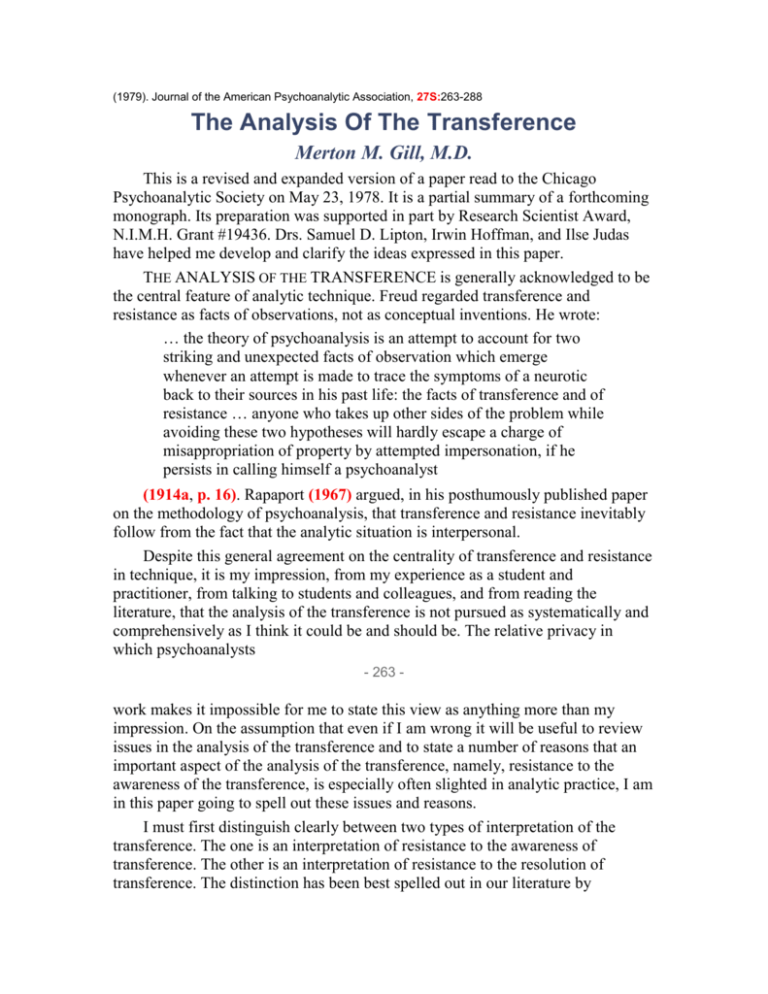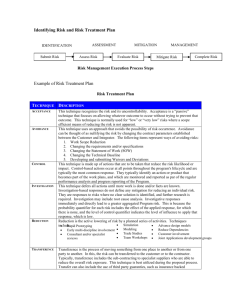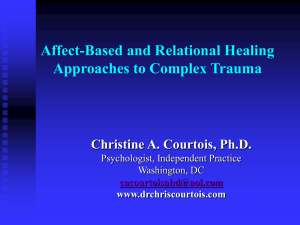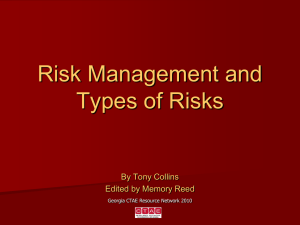Standard Edition
advertisement

(1979). Journal of the American Psychoanalytic Association, 27S:263-288 The Analysis Of The Transference Merton M. Gill, M.D. This is a revised and expanded version of a paper read to the Chicago Psychoanalytic Society on May 23, 1978. It is a partial summary of a forthcoming monograph. Its preparation was supported in part by Research Scientist Award, N.I.M.H. Grant #19436. Drs. Samuel D. Lipton, Irwin Hoffman, and Ilse Judas have helped me develop and clarify the ideas expressed in this paper. THE ANALYSIS OF THE TRANSFERENCE is generally acknowledged to be the central feature of analytic technique. Freud regarded transference and resistance as facts of observations, not as conceptual inventions. He wrote: … the theory of psychoanalysis is an attempt to account for two striking and unexpected facts of observation which emerge whenever an attempt is made to trace the symptoms of a neurotic back to their sources in his past life: the facts of transference and of resistance … anyone who takes up other sides of the problem while avoiding these two hypotheses will hardly escape a charge of misappropriation of property by attempted impersonation, if he persists in calling himself a psychoanalyst (1914a, p. 16). Rapaport (1967) argued, in his posthumously published paper on the methodology of psychoanalysis, that transference and resistance inevitably follow from the fact that the analytic situation is interpersonal. Despite this general agreement on the centrality of transference and resistance in technique, it is my impression, from my experience as a student and practitioner, from talking to students and colleagues, and from reading the literature, that the analysis of the transference is not pursued as systematically and comprehensively as I think it could be and should be. The relative privacy in which psychoanalysts - 263 - work makes it impossible for me to state this view as anything more than my impression. On the assumption that even if I am wrong it will be useful to review issues in the analysis of the transference and to state a number of reasons that an important aspect of the analysis of the transference, namely, resistance to the awareness of the transference, is especially often slighted in analytic practice, I am in this paper going to spell out these issues and reasons. I must first distinguish clearly between two types of interpretation of the transference. The one is an interpretation of resistance to the awareness of transference. The other is an interpretation of resistance to the resolution of transference. The distinction has been best spelled out in our literature by Greenson (1967) and Stone (1967). The first kind of resistance may be called defense transference. Although that term is mainly employed to refer to a phase of analysis characterized by a general resistance to the transference of wishes, it can also be used for a more isolated instance of transference of defense. The second kind of resistance is usually called transference resistance. With some oversimplification, one might say that in resistance to the awareness of transference, the transference is what is resisted, whereas in resistance to the resolution of transference, the transference is what does the resisting. Another more descriptive way of stating this distinction between resistance to the awareness of transference and resistance to the resolution of transference is between implicit or indirect references to the transference and explicit or direct references to the transference. The interpretation of resistance to awareness of the transference is intended to make the implicit transference explicit, while the interpretation of resistance to the resolution of transference is intended to make the patient realize that the already explicit transference does indeed include a determinant from the past. It is also important to distinguish between the general - 264 - concept of an interpretation of resistance to the resolution of transference and a particular variety of such an interpretation, namely, a genetic transference interpretation-that is, an interpretation of how an attitude in the present is an inappropriate carry-over from the past. While there is a tendency among analysts to deal with explicit references to the transference primarily by a genetic transference interpretation, there are other ways of working toward a resolution of the transference. This paper will argue that not only is not enough emphasis being given to interpretation of the transference in the here and now, that is, to the interpretation of implicit manifestations of the transference, but also that interpretations intended to resolve the transference as manifested in explicit references to the transference should be primarily in the here and now, rather than genetic transference interpretations. A patient's statement that he feels the analyst is harsh, for example, is, at least to begin with, likely best dealt with not by interpreting that this is a displacement from the patient's feeling that his father was harsh but by an elucidation of some other aspect of this here-and-now attitude, such as what has gone on in the analytic situation that seems to the patient to justify his feeling or what was the anxiety that made it so difficult for him to express his feelings. How the patient experiences the actual situation is an example of the role of the actual situation in a manifestation of transference, which will be one of my major points. Of course, both interpretations of the transference in the here and now and genetic transference interpretations are valid and constitute a sequence. We presume that a resistance to the transference ultimately rests on the displacement onto the analyst of attitudes from the past. Transference interpretations in the here and now and genetic transference interpretations are of course exemplified - 265 - in Freud's writings and are in the repertoire of every analyst, but they are not distinguished sharply enough. Because Freud's case histories focus much more on the yield of analysis than on the details of the process, they are readily but perhaps incorrectly construed as emphasizing work outside the transference much more than work with the transference, and, even within the transference, emphasizing genetic transference interpretations much more than work with the transference in the here and now (see Muslin and Gill, 1978). The example of Freud's case reports may have played a role in what I consider a common maldistribution of emphasis in these two respects — not enough on the transference and, within the transference, not enough on the here and now. Before I turn to the issues in the analysis of the transference, I will only mention what is a primary reason for a failure to deal adequately with the transference. It is that work with the transference is that aspect of analysis which involves both analyst and patient in the most affect-laden and potentially disturbing interactions. Both participants in the analytic situation are motivated to avoid these interactions. Flight away from the transference and to the past can be a relief to both patient and analyst. I divide my discussion into five parts: (1) the principle that the transference should be encouraged to expand as much as possible within the analytic situation because the analytic work is best done within the transference; (2) the interpretation of disguised allusions to the transference as a main technique for encouraging the expansion of the transference within the analytic situation; (3) the principle that all transference has a connection with something in the present actual analytic situation; (4) how the connection between transference and the actual analytic situation is used in interpreting resistance to the awareness of transference; and (5) the resolution of transference within the here and now and the role of genetic transference interpretation. - 266 - The Principle of Encouraging the Transference to Expand within the Analytic Situation The importance of transference interpretations will surely be agreed to by all analysts, the greater effectiveness of transference interpretations than interpretations outside the transference will be agreed to by many, but what of the relative roles of interpretation of the transference and interpretation outside the transference? Freud can be read either as saying that the analysis of the transference is auxiliary to the analysis of the neurosis or that the analysis of the transference is equivalent to the analysis of the neurosis. The first position is stated in his saying (1913, p. 144) that the disturbance of the transference has to be overcome by the analysis of transference resistance in order to get on with the work of analyzing the neurosis. It is also implied in his reiteration that the ultimate task of analysis is to remember the past, to fill in the gaps in memory. The second position is stated in his saying that the victory must be won on the field of the transference (1912, p. 108) and that the mastery of the transference neurosis "coincides with getting rid of the illness which was originally brought to the treatment" (1917, p. 444). In this second view, he says that after the resistances are overcome, memories appear relativey without difficulty (1914b, p. 155). These two different positions also find expression in the two very different ways in which Freud speaks of the transference. In "Dynamics of Transference," he refers to the transference, on the one hand, as "the most powerful resistance to the treatment" (1912, p. 101) but, on the other hand, as doing us "the inestimable service of making the patient's … impulses immediate and manifest. For when all is said and done, it is impossible to destroy anyone in absentia or in effigie" (1912, p. 108). I believe it can be demonstrated that his principal emphasis falls on the second position. He wrote once, in - 267 - summary: Thus our therapeutic work falls into two phases. In the first, all the libido is forced from the symptoms into the transference and concentrated there; in the second, the struggle is waged around this new object and the libido is liberated from it (1917, p. 455). The detailed demonstration that he advocated that the transference should be encouraged to expand as much as possible within the analytic situation lies in clarifying that resistance is primarily expressed by repetition, that repetition takes place both within and outside the analytic situation, but that the analyst seeks to deal with it primarily within the analytic situation, that repetition can be not only in the motor sphere (acting) but also in the psychical sphere, and that the psychical sphere is not confined to remembering but includes the present, too. Freud's emphasis that the purpose of resistance is to prevent remembering can obscure his point that resistance shows itself primarily by repetition, whether inside or outside the analytic situation: "The greater the resistance, the more extensively will acting out (repetition) replace remembering" (1914b, p. 151). Similarly in "The Dynamics of Transference" Freud said that the main reason that the transference is so well suited to serve the resistance is that the unconscious impulses "do not want to be remembered … but endeavour to reproduce themselves …" (1912, p. 108). The transference is a resistance primarily insofar as it is a repetition. The point can be restated in terms of the relation between transference and resistance. The resistance expresses itself in repetition, that is, in transference both inside and outside the analytic situation. To deal with the transference, therefore, is equivalent to dealing with the resistance. Freud emphasized transference within the analytic situation so strongly that it has come to mean only repetition within the analytic situation, even though, conceptually speaking, repetition outside the analytic situation is transference too, and Freud once used the term that way: We soon perceive - 268 - that the transference is itself only a piece of repetition, and that the repetition is a transference of the forgotten past not only on to the doctor but also on to all the other aspects of the current situation. We … find … the compulsion to repeat, which now replaces the impulsion to remember, not only in his personal attitude to his doctor but also in every other activity and relationship which may occupy his life at the time … (1914b, p. 151). It is important to realize that the expansion of the repetition inside the analytic situation, whether or not in a reciprocal relationship to repetition outside the analytic situation, is the avenue to control the repetition: "The main instrument … for curbing the patient's compulsion to repeat and for turning it into a motive for remembering lies in the handling of the transference. We render the compulsion harmless, and indeed useful, by giving it the right to assert itself in a definite field" (1914b, p. 154). Kanzer has discussed this issue well in his paper on "The Motor Sphere of the Transference" (1966). He writes of a "double-pronged stick-and-carrot" technique by which the transference is fostered within the analytic situation and discouraged outside the analytic situation. The "stick" is the principle of abstinence as exemplified in the admonition against making important decisions during treatment, and the "carrot" is the opportunity afforded the transference to expand within the treatment "in almost complete freedom" as in a "playground" (Freud, 1914b, p. 154). As Freud put it: Provided only that the patient shows compliance enough to respect the necessary conditions of the analysis, we regularly succeed in giving all the symptoms of the illness a new transference meaning and in replacing his ordinary neurosis by a 'transference neurosis' of which he can be cured by the therapeutic work (1914b, p. 154). The reason it is desirable for the transference to be expressed within the treatment is that there, it "is at every point accessible to our intervention" (1914b, p. 154). In a - 269 - later statement he made the same point this way: "We have followed this new edition [the transference-neurosis] of the old disorder from its start, we have observed its origin and growth, and we are especially well able to find our way about in it since, as its object, we are situated at its very center" (1917, p. 444). It is not that the transference is forced into the treatment, but that it is spontaneously but implicitly present and is encouraged to expand there and become explicit. Freud emphasized acting in the transference so strongly that one can overlook that repetition in the transference does not necessarily mean it is enacted. Repetition need not go as far as motor behavior. It can also be expressed in attitudes, feelings, and intentions, and, indeed, the repetition often does take such form rather than motor action. Such repetition is in the psychical rather than the motor sphere. The importance of making this clear is that Freud can be mistakenly read to mean that repetition in the psychical sphere can only mean remembering the past, as when he writes that the analyst is prepared for a perpetual struggle with his patient to keep in the psychical sphere all the impulses which the patient would like to direct into the motor sphere; and he celebrates it as a triumph for the treatment if he can bring it about that something the patient wishes to discharge in action is disposed of through the work of remembering (1914b, p. 153). It is true that the analyst's effort is to convert acting in the motor sphere into awareness in the psychical sphere, but transference may be in the psychical sphere to begin with, albeit disguised. The psychical sphere includes awareness in the transference as well as remembering. One of the objections one hears, from both analysts and patients, to a heavy emphasis on interpretation of associations about the patient's real life primarily in terms of the transference is that it means the analyst is disregarding the importance of what goes on in the patient's real life. The - 270 - criticism is not justified. To emphasize the transference meaning is not to deny or belittle other meanings, but to focus on the one of several meanings of the content that is the most important for the analytic process, for the reasons I have just summarized. Another way in which interpretations of resistance to the transference can be, or at least appear to the patient to be, a belittling of the importance of the patient's outside life is to make the interpretation as though the outside behavior is primarily an acting out of the transference. The patient may undertake some actions in the outside world as an expression of and resistance to the transference, that is, acting out. But the interpretation of associations about actions in the outside world as having implications for the transference need mean only that the choice of outside action to figure in the associations is codetermined by the need to express a transference indirectly. It is because of the resistance to awareness of the transference that the transference has to be disguised. When the disguise is unmasked by interpretation, it becomes clear that, despite the inevitable differences between the outside situations and the transference situation, the content is the same for the purpose ofthe analytic work. Therefore the analysis of the transference and the analysis of the neurosis coincide. I stress this point particularly because some critics of earlier versions of this paper argued that I was advocating the analysis of the transference for its own sake rather than in the effort to overcome the neurosis. As I cited above, Freud wrote that the mastering of the transference neurosis coincides with getting rid of the illness which was originally brought to the treatment (1917, p. 444). How the Transference Is Encouraged to Expand within the Analytic Situation The analytic situation itself fosters the development of - 271 - attitudes with primary determinants in the past, i.e., transferences. The analyst's reserve provides the patient with few and equivocal cues. The purpose of the analytic situation fosters the development of strong emotional responses, and the very fact that the patient has a neurosis means, as Freud said, that … it is a perfectly normal and intelligible thing that the libidinal cathexis [we would now add negative feelings] of someone who is partly unsatisfied, a cathexis which is held ready in anticipation, should be directed as well to the figure of the doctor (1912, p. 100.). While the analytic setup itself fosters the expansion of the transference within the analytic situation, the interpretation of resistance to the awareness of transference will further this expansion. There are important resistances on the part of both patient and analyst to awareness of the transference. On the patient's part, this is because of the difficulty in recognizing erotic and hostile impulses toward the very person to whom they have to be disclosed. On the analyst's part, this is because the patient is likely to attribute the very attitudes to him which are most likely to cause him discomfort. The attitudes the patient believes the analyst has toward him are often the ones the patient is least likely to voice, in a general sense because of a feeling that it is impertinent for him to concern himself with the analyst's feelings, and in a more specific sense because the attitudes the patient ascribes to the analyst are often attitudes the patient feels the analyst will not like and be uncomfortable about having ascribed to him. It is for this reason that the analyst must be especially alert to the attitudes the patient believes he has, not only to the attitudes the patient does have toward hm. If the analyst is able to see himself as a participant in an interaction, as I shall discuss below, he will become much more attuned to this important area of transference, which might otherwise escape him. The investigation of the attitudes ascribed to the analyst - 272 - makes easier the subsequent investigation of the intrinsic factors in the patient that played a role in such ascription. For example, the exposure of the fact that the patient ascribes sexual interest in him to the analyst, and genetically to the parent, makes easier the subsequent exploration of the patient's sexual wish toward the analyst, and genetically the parent. The resistances to the awareness of these attitudes is responsible for their appearing in various disguises in the patient's manifest associations and for the analyst's reluctance to unmask the disguise. The most commonly recognized disguise is by displacement, but identification is an equally important one. In displacement, the patient's attitudes are narrated as being toward a third party. In identification, the patient attributes to himself attitudes he believes the analyst has toward him. To encourage the expansion of the transference within the analytic situation, the disguises in which the transference appears have to be interpreted. In the case of displacement the interpretation will be of allusions to the transference in associations not manifestly about the transference. This is a kind of interpretation every analyst often makes. In the case of identification, the analyst interprets the attitude the patient ascribes to himself as an identification with an attitude he attributes to the analyst. Lipton (1977b) has recently described this form of disguised allusion to the transference with illuminating illustrations. Many analysts believe that transference manifestations are infrequent and sporadic at the beginning of an analysis and that the patient's associations are not dominated by the transference unless a transference neurosis has developed. Other analysts believe that the patient's associations have transference meanings from the beginning and throughout. That is my opinion, and I think those who believe otherwise are failing to recognize the pervasiveness of indirect allusions - 273 - to the transference — that is, what I am calling the resistance to the awareness of the transference. In his autobiography, Freud wrote: The patient remains under the influence of the analytic situation even though he is not directing his mental activities on to a particular subject. We shall be justified in assuming that nothing will occur to him that has not some reference to that situation (1925, pp. 40-41). Since associations are obviously often not directly about the analytic situation, the interpretation of Freud's remark rests on what he meant by the "analytic situation." I believe Freud's meaning can be clarified by reference to a statement he made in "The Interpretation of Dreams." He said that when the patient is told to say whatever comes into his mind, his associations become directed by the "purposive ideas inherent in the treatment" and that there are two such inherent purposive themes, one relating to the illness and the other — concerning which, Freud said, the patient has "no suspicion" — relating to the analyst (1900, pp. 531-532). If the patient has "no suspicion" of the theme relating to the analyst, the clear implication is that the theme appears only in disguise in the patient's associations. My interpretation is that Freud's remark not only specifies the themes inherent in the patient's associations, but also means that the associations are simultaneously directed by these two purposive ideas, not sometimes by one and sometimes by the other. One important reason that the early and continuing presence of the transference is not always recognized is that it is considered to be absent in the patient who is talking freely and apparently without resistance. As Muslin and I pointed out in a paper on the early interpretation of transference (Gill and Muslin, 1976), resistance to the transference is probably present from the beginning, even if the patient is talking apparently freely. The patient may well be talking about issues not manifestly about the transference - 274 - which are nevertheless also allusions to the transference. But the analyst has to be alert to the pervasiveness of such allusions to discern them. The analyst should proceed on the working assumption, then, that the patient's associations have transference implications pervasively. This assumption is not to be confused with denial or neglect of the current aspects of the analytic situation. It is theoretically always possible to give precedence to a transference interpretation if one can only discern it through its disguise by resistance. This is not to dispute the desirability of learning as much as one can about the patient, if only to be in a position to make more correct interpretations of the transference. One therefore does not interfere with an apparently free flow of associations, especially early, unless the transference threatens the analytic situation to the point where its interpretation is mandatory rather than optional. With the recognition that even the apparently freely associating patient may also be showing resistance to awareness of the transference, the formulation that one should not interfere as long as useful information is being gathered should replace Freud's dictum that the transference should not be interpreted until it becomes a resistance (1913, p. 139). Connection of All Transference Manifestations with Something in the Actual Analytic Situation As a prelude to a further discussion of the interpretive technique for expansion of the transference within the analytic situation, I will argue that every transference has some connection to some aspect of the current analytic situation. Of course all the determinants of a transference are current in the sense that the past can exert an influence only insofar as it exists in the present. What I am distinguishing is the current reality of the analytic situation, that is, what - 275 - actually goes on between patient and analyst in the present, from how the patient is currently constituted as a result of his past. All analysts would doubtless agree that there are both current and transferential determinants of the analytic situation, and probably no analyst would argue that a transference idea can be expressed without contamination, as it were, that is, without any connection to anything current in the patient-analyst relationship. Nevertheless, I believe the implications of this fact for technique are often neglected in practice. I will deal with them as my next point. Here I want only to argue for the connection. Several authors (e.g., Kohut, 1959), (Loewald, 1960) have pointed out that Freud's early use of the term transference in "The Interpretation of Dreams," in a connection not immediately recognizable as related to the present-day use of the term, reveals the fallacy of considering that transference can be expressed free of any connection to the present. That early use was to refer to the fact that an unconscious idea cannot be expressed as such, but only as it becomes connected to a preconscious or conscious content. In the phenomenon with which Freud was then concerned, the dream, transference took place from an unconscious wish to a day residue. In "The Interpretation of Dreams" Freud used the term transference both for the general rule that an unconscious content is expressible only as it becomes transferred to a preconscious or conscious content and for the specific application of this rule to a transference to the analyst. Just as the day rsidue is the point of attachment of the dream wish, so must there be an analytic-situation residue, though Freud did not use that term, as the point of attachment of the transference. Analysts have always limited their behavior, both in variety and intensity, to increase the extent to which the patient's behavior is determined by his idiosyncratic interpretation of the analyst's behavior. In fact, analysts unfortunately - 276 - sometimes limit their behavior so much, as compared with Freud's practice, that they even conceptualize the entire relationship with the patient a matter of technique, with no nontechnical personal relation, as Lipton (1977a) has pointed out. But no matter how far the analyst attempts to carry this limitation of his behavior, the very existence of the analytic situation provides the patient with innumerable cues which inevitably become his rationale for his transference responses. In other words, the current situation cannot be made to disappear — that is, the analytic situation is real. It is easy to forget this truism in one's zeal to diminish the role of the current situation in determining the patient's responses. One can try to keep past and present determinants relatively perceptible from one another, but one cannot obtain either in "pure culture." As Freud wrote: "I insist on this procedure [the couch], however, for its purpose and result are to prevent the transference from mingling with the patient's associations imperceptibly, to isolate the transference and to allow it to come forward in due course sharply defined as a resistance" (1913, p. 134). Even "isolate" is too strong a word in the ligt of the inevitable intertwining of the transference with the current situation. If the analyst remains under the illusion that the current cues he provides to the patient can be reduced to the vanishing point, he may be led into a silent withdrawal, which is not too distant from the caricature of an analyst as someone who does indeed refuse to have any personal relationship with the patient. What happens then is that silence has become a technique rather than merely an indication that the analyst is listening. The patient's responses under such conditions can be mistaken for uncontaminated transference when they are in fact transference adaptations to the actuality of the silence. The recognition that all transference must have some relation to the actual analytic situation, from which it takes - 277 - its point of departure, as it were, has a crucial implication for the technique of interpreting resistance to the awareness of transference, to which I turn now. The Role of the Actual Situation in Interpreting Resistance to the Awareness of Transference If the analyst becomes persuaded of the centrality of transference and the importance of encouraging the transference to expand within the analytic situation, he has to find the presenting and plausible interpretations of resistance to the awareness of transference he should make. Here, his most reliable guide is the cues offered by what is actually going on in the analytic situation: on the one hand, the events of the situation, such as change in time of session, or an interpretation made by the analyst, and, on the other hand, how the patient is experiencing the situation as reflected in explicit remarks about it, however fleeting these may be. This is the primary yield for technique of the recognition that any transference must have a link to the actuality of the analytic situation, as I argued above. The cue points to the nature of the transference, just as the day residue for a dream may be a quick pointer to the latent dream thoughts. Attention to the current stimulus for a transference elaboraton will keep the analyst from making mechanical transference interpretations, in which he interprets that there are allusions to the transference in associations not manifestly about the transference, but without offering any plausible basis for the interpretation. Attention to the current stimulus also offers some degree of protection against the analyst's inevitable tendency to project his own views onto the patient, either because of countertransference or because of a preconceived theoretical bias about the content and hierarchical relationships in psychodynamics. The analyst may be very surprised at what in his behavior the patient finds important or unimportant, for the - 278 - patient's responses will be idiosyncratically determined by the transference. The patient's response may seem to be something the patient as well as the analyst consider trivial, because, as in displacement to a trivial aspect of the day residue of a dream, displacement can better serve resistance when it is to something trivial. Because it is connected to conflict-laden material, the stimulus to the transference may be difficult to find. It may be quickly disavowed, so that its presence in awareness is only transitory. With the discovery of the disavowal, the patient may also gain insight into how it repeats a disavowal earlier in his life. In his search for the present stimuli which the patient is responding to transferentially, the analyst must therefore remain alert to both fleeting and apparently trivial manifest references to himself as well as to the events of the analytic stuation. If the analyst interprets the patient's attitudes in a spirit of seeing their possible plausibility in the light of what information the patient does have, rather than in the spirit of either affirming or denying the patient's views, the way is open for their further expression and elucidation. The analyst will be respecting the patient's effort to be plausible and realistic, rather than seeing him as manufacturing his transference attitudes out of whole cloth. I believe it is so important to make a transference interpretation plausible to the patient in terms of a current stimulus that, if the analyst is persuaded that the manifest content has an important implication for the transference but he is unable to see a current stimulus for the attitude, he should explicitly say so if he decides to make the transference interpretation anyway. The patient himself may then be able to say what the current stimulus is. It is sometimes argued that the analyst's attention to his own behavior as a precipitant for the transference will increase the patient's resistance to recognizing the transference. I believe, on the contrary, that, because of the inevitable interrelationship of the current and transferential determinants, - 279 - it is only through interpretation that they can be disentangled. It is also argued that one must wait until the transference has reached optimal intensity before it can be advantageously interpreted. It is true that too hasty an interpretation of the transference can serve a defensive function for the analyst and deny him the information he needs to make a more appropriate transference interpretation. But it is also true that delay in interpreting runs the risks of allowing an unmanageable transference to develop. It is also true that deliberate delay can be a manipulation in the service of abreaction rather than analysis and, like silence, can lead to a response to the actual situation which is mistaken for uncontaminated transference. Obviously important issues of timing are involved. I believe an important clue to when a transference interpretation is apt and which one to make lies in whether the interpretation can be made plausibly in terms of the determinant I am stressing, namely, something in the current analytic situation. A critic of an earlier version of this paper understood me to be saying that all that the analyst need to is to interpret the allusion to the transference, but that I did not see that interpretation of why the transference had to be expressed by allusion rather than directly is also necessary. Of course I agree, and meant to imply this as well as other aspects of the transference attitude in saying that when the analyst approaches the transference in the spirit of seeing how it appears plausibly realistic to the patient, it paves the way toward its further elucidation and expression. The Relative Roles of Resolution of the Transference within the Analytic Situation and by Genetic Transference Interpretation Freud's emphasis on remembering as the goal of the analytic work implies that remembering is the principal avenue to the resolution of the transference. But his delineation of the - 280 - successive steps in the development of analytic technique (1920, p. 18) makes clear that he saw this development as a change from an effort to reach memories directly to the utilization of the transference as the necessary intermediary to reaching the memories. In contrast to remembering as the way the transference is resolved, Freud also described resistance as being primarily overcome in the transference, with remembering following relatively easily thereafter: From the repetitive reactions which are exhibited in the transference we are led along the familiar paths to the awakening of the memories, which appear without difficulty, as it were, after the resistance has been overcome (1914b, pp. 154-155); and This revision of the process of repression can be accomplished only in part in connection with the memory traces of the process which led to repression. The decisive part of the work is achieved by creating in the patient's relation to the doctor — in the 'transference' — new editions of the old conflicts. … Thus the transference becomes the battlefield on which all the mutually struggling forces should meet one another (1917, p. 454; emphasis added). This is indeed the primary insight Strachey (1934) clarified in his seminal paper on the therapeutic action of psychoanalysis. There are two main ways in which resolution of the transference can take place through work with the transference in the here and now. The first lies in the clarification of what are the cues in the current situation which are the patient's point of departure for a transference elaboration. The exposure of the current point of departure at once raises the question of whether it is adequate to the conclusion drawn from it. The relating of the transference to a current stimulus is, after all, part of the patient's effort to make the transference attitude plausibly determined by the present. The reserve and ambiguity of the analyst's behavior is what increases the ranges of apparently plausible conclusions the patient may draw. If an examination of the basis for the - 281 - conclusion makes clear that the actual situation to which the patient responds is subject to other meanings than the one the patient has reached, he will more readily consider his pre-existing bias, that is, his transference. Another critic of an earlier version of this paper suggested that, in speaking of the current relationship and the relation between the patient's conclusions and the information on which they seem plausibly based, I am implying some absolute conception of what is real in the analytic situation, of which the analyst is the final arbiter. That is not the case. My writing that what the patient must come to see is that the information he has is subject to other possible interpretations implies the very contrary to an absolute conception of reality. In fact, analyst and patient engage in a dialogue in a spirit of attempting to arrive at a consensus about reality, not about some fictitious absolute reality. The second way in which resolution of the transference can take place within the work with the transference in the here and now is that in the very interpretation of the transference the patient has a new experience. He is being treated differently from how he expected to be. Analysts seem reluctant to emphasize this new experience, as though it endangers the role of insight and argues for interpersonal influence as the significant factor in change. Strachey's emphasis on the new experience in the mutative transference interpretation has unfortunately been overshadowed by his views on introjection, which have been mistaken to advocate manipulating the transference. Strachey meant introjection of the more benign superego of the analyst only as a temporary step on the road toward insight. Not only is the new experience not to be confused with the interpersonal influence of a transference gratification, but the new experience occurs together with insight into both the patient's biased expectation and the new experience. As Strachey points out, what is unique about the transference interpretation - 282 - is that insight and the new experience take place in relation to the very person who was expected to behave differently, and it is this which gives the work in the transference its immediacy and effectiveness. While Freud did stress the affective immediacy of the transference, he did not make the new experience explicit. It is important to recognize that transference interpretation is not a matter of experience, in contrast to insight, but a joining of the two together. Both are needed to bring about and maintain the desired changes in the patient. It is also important to recognize that no new techniques of intervention are required to provide the new experience. It is an inevitable accompaniment of interpretation of the transference in the here and now. It is often overlooked that, although Strachey said that only transference interpretations were mutative, he also said with approval that most interpretations are outside the transference. In a further explication of Strachey's paper and entirely consistent with Strachey's position, Rosenfeld (1972) has pointed out that clarification of material outside the transference is often necessary to know what is the appropriate transference interpretation, and that both genetic transference interpretations and extratransference interpretations play an important role in working through. Strachey said relatively little about working through, but surely nothing against the need for it, and he explicitly recognized a role for recovery of the past in the resolution of the transference. My own position is to emphasize the role of the analysis of the transference in the here and now, both in interpreting resistance to the awareness of transference and in working toward its resolution by relating it to the actuality of the situation. I agree that extratransference and genetic transference interpretations and, of course, working through are important too. The matter is one of emphasis. I believe interpretation of resistance to awareness of the transference - 283 - should figure in the majority of sessions, and that if this is done by relating the transference to the actual analytic situation, the very same interpretation is a beginning of work to the resolution of the transference. To justify this view more persuasively would require detailed case material. It may be considered that I am siding with the Kleinians who, many analysts feel, are in error in giving the analysis of the transference too great if not even an exclusive role in the analytic process. It is true that Kleinians emphasize the analysis of the transference more, in their writings at least, than do the general run of analysts. Indeed, Anna Freud's (1968) complaint that the concept of transference has become overexpanded seems to be directed against the Kleinians. One of the reasons the Kleinians consider themselves the true followers of Freud in technique is precisely because of the emphasis they put on the analysis of the transference. Hanna Segal (1967, pp. 173-174), for example, writes as follows: "To say that all communications are seen as communications about the patient's phantasy as well as current external life is equivalent to saying that all communications contain something relevant to the transference situation. In Keinian technique, the interpretation of the transference is often more central than in the classical technique." Despite their disclaimers to the contrary, my reading of Kleinian case material leads me to agree with what I believe is the general view that Kleinian transference interpretations often deal with so-called deep and genetic material without adequate connection to the current features of the present analytic situation and thus differ sharply from the kind of transference interpretation I am advocating. The insistence on exclusive attention to any particular aspect of the analytic process, like the analysis of the transference in the here and now, can become a fetish. I do not say that other kinds of interpretation should not be made, but I feel the emphasis on transference interpretations within the analytic situation needs to be increased or at the very - 284 - least reaffirmed, and that we need more clarification and specification of just when other kinds of interpretations are in order. Of course it is sometimes tactless to make a transference interpretation. Surely two reasons which would be included in a specification of the reasons for not making a particular transference interpretation, even if one seems apparent to the analyst, would be preoccupation with an important extratransference event and an inadequate degree of rapport, to use Freud's term, to sustain the sense of criticism, humiliation, or other painful feeling the particular interpretation might engender, even though the analyst had no intention of evoking such a response. The issue may well be, however, not of whether or not an interpretation of resistance to the transference should be made, but whether the therapist can find that transference interpretation which in the light of the total situation, both transferential and current, the patient is able to hear and benefit from primarily as the analyst intends it. Transference interpretations, like extratransference interpretations, indeed like any behavior on the analyst's part, can have an effect on the transference, which in turn needs to be examined if the result of an analysis is to depend as little as possible on unanalyzed transference. The result of any analysis depends on the analysis of the transference, persisting effects of unanalyzed transference, and the new experience which I have emphasized as the unique merit of transference interpretation in the here and now. It is especially important to remember this lest one's zeal to ferret out the transference itself become an unrecognized and objectionable actual behavior on the analyst's part, with its own repercussions on the transference. The emphasis I am placing on the analysis of resistance to the transference could easily be misunderstood as implying that it is always easy to recognize the transference as disguised by resistance or that analysis would proceed - 285 - without a hitch if only such interpretations were made. I mean to imply neither, but rather that the analytic process will have the best chance of success if correct interpretation of resistance to the transference and work with the transference in the here and now are the core of the analytic work. I close with a statement of a conviction designed to set this paper into a broader perspective of psychoanalytic theory and research. The points I have made are not new. They are present in varying degrees of clarity and emphasis throughout our literature. But like so many other aspects of psychoanalytic theory and practice, they fade in and out of prominence and are rediscovered again and again, possibly occasionally with some modest conceptual advance, but often with a newness attributable only to ignorance of past contributions. There are doubtless many reasons for this phenomenon. But not the least, in my opinion, is the almost total absence of systematic and controlled research in the psychoanalytic situation. I mean such research in contrast to the customary clinical research. I believe that only with such systematic and controlled research will analytic findings become solid and secure knowledge instead of being subject to erosion again and again by waves of fashion and what Ernst Lewy (1941) long ago called the "return of the repression" to designate the retreat by psychoanalysts from insights they had once reached. Summary Let me summarize. I distinguish between two major different relationships between transference and resistance. One is resistance to awareness of the transference and the other is resistance to resolution of the transference. I argue that the bulk of the analytic work should take place in the transference in the here and now. I detailed Freud's view that the transference should be encouraged to - 286 - expand within the analytic situation. I suggested that the main technique for doing so, in addition to the analytic setup itself, is the interpretation of resistance to the awareness of transference by searching for the allusions to the transference in the associations not manifestly about the transference; that in making such interpretations one is guided by the connection to the actual analytic situation which every transference includes; that the major work in resolving the transference takes place in the here and now, both by way of examining the relation between the transference and the actuality of the analytic situation from which it takes its point of departure and the new experience which the analysis of the transference inevitably includes; and that, while genetic transference interpretations play a role in resolvng the transference, genetic material is likely to appear spontaneously and with relative ease after the resistances have been overcome in the transference in the here and now. Working through remains important, and it, too, takes place primarily in the transference in the here and now. REFERENCES Freud, A. (1968). Acting out. Writings, 7: 94-109. New York: International Universities Press 1971. Freud, S. (1900). The interpretation of dreams. Standard Edition, 5: [→] Freud, S. (1912). The dynamics of transference. Standard Edition, 12:99-108. [→] Freud, S. (1913). On beginning the treatment (Further recommendations in the technique of psychoanalysis, I). Standard Edition, 12:123-144. [→] Freud, S. (1914a). On the history of the psycho-analytic movement. Standard Edition, 14:7-66. [→] Freud, S. (1914b). Remembering, repeating, and working through (Further recommendations on the technique of psycho-analysis, II). Standard Edition, 12:147-156. [→] Freud, S. (1917). Introductory lectures on psycho-analysis. Standard Edition, 16: [→] Freud, S. (1920). Beyond the pleasure principle. Standard Edition, 18:7-64. [→] Freud, S. (1925). An autobiographical study. Standard Edition, 20:7-74. London: Hogarth Press 1959. [→] Gill, M. & Muslin, H. (1976). Early interpretation of transference. J. Am. Psychoanal. Assoc., 24:779-794. [→] Greenson, R. (1967). The Technique and Practice of Psychoanalysis New York: International Universities Press - 287 - Kanzer, M. (1966). The motor sphere of the transference.Psychoanal. Q., 35:522539. [→] Kohut, H. (1959). Introspection, empathy, and psychoanalysis. In: The Search for the Self New York: International Universities Press 1978.pp. 205-232. Lewy, E. (1941). The return of the repression. Bull. Menninger Clinic, 5: 47-55. Lipton, S. (1977b). Clinical observations on resistance to the transference.Int. J. Psychoanal., 58:463-472. [→] Loewald, H. (1960). On the therapeutic action of psychoanalysis.Int. J. Psychoanal., 41:16-33. [→] Muslin, H. & Gill, M. (1978). Transference in the Dora case. J. Am. Psychoanal. Assoc., 26:311-328. [→] Rapaport, D. (1967). The scientific methodology of psychoanalysis. In: Collected Papers ed. M. M. Gill. New York: Basic Books 1967.pp. 165-220. Rosenfeld, H. (1972). A critical appreciation of James Strachey's paper on the nature of the therapeutic action of psychoanalysis.Int. J. Psychoanal., 53:455462. [→] Segal, H. (1967). Melanie Klein's technique. In: Psychoanalytic Techniques ed. B. Wolman. New York: Basic Books pp. 168-190. Stone, L. (1967). The psychoanalytic situation and transference. J. Am. Psychoanal. Assoc., 15:3-57. [→] Strachey, J. (1934). The nature of the therapeutic action of psychoanalysis. Reprinted in Int. J. Psychoanal. (1969)., 50:275-292. [→] Article Citation [Who Cited This?] Gill, M.M. (1979). The Analysis Of The Transference. J. Amer. Psychoanal. Assn., 27S:263-288









